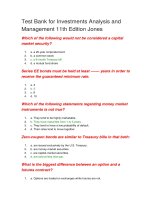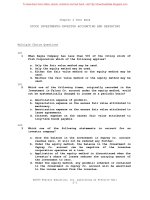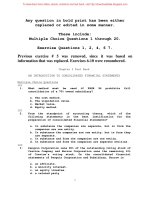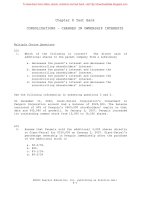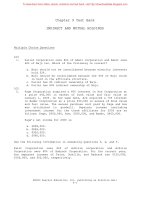Test bank investments 10e zvi bodie
Bạn đang xem bản rút gọn của tài liệu. Xem và tải ngay bản đầy đủ của tài liệu tại đây (739.03 KB, 15 trang )
www.acetxt.com
Chapter 01
The Investment Environment
Multiple Choice Questions
1. The material wealth of a society is a function of
A. all financial assets.
B. all real assets.
C. all financial and real assets.
D. all physical assets.
2. _______ are real assets.
A. Land
B. Machines
C. Stocks and bonds
D. Knowledge
E. Land, machines, and knowledge
1-1
Copyright © 2014 McGraw-Hill Education. All rights reserved. No reproduction or distribution without the prior written consent of
McGraw-Hill Education.
www.acetxt.com
3. The means by which individuals hold their claims on real assets in a well-developed economy
are
A. investment assets.
B. depository assets.
C. derivative assets.
D. financial assets.
E. exchange-driven assets.
4. _______ are financial assets.
A. Bonds
B. Machines
C. Stocks
D. Bonds and stocks
E. Bonds, machines, and stocks
5. _________ financial asset(s).
A. Buildings are
B. Land is a
C. Derivatives are
D. U.S. agency bonds are
E. Derivatives and U.S. agency bonds are
1-2
Copyright © 2014 McGraw-Hill Education. All rights reserved. No reproduction or distribution without the prior written consent of
McGraw-Hill Education.
www.acetxt.com
6. Financial assets
A. directly contribute to the country's productive capacity.
B. indirectly contribute to the country's productive capacity.
C. contribute to the country's productive capacity both directly and indirectly.
D. do not contribute to the country's productive capacity either directly or indirectly.
E. are of no value to anyone.
7. In 2012, ____________ was the most significant real asset of U.S. households in terms of total
value.
A. consumer durables
B. automobiles
C. real estate
D. mutual fund shares
E. bank loans
8. In 2012, ____________ was the least significant financial asset of U.S. households in terms of
total value.
A. real estate
B. mutual fund shares
C. debt securities
D. life insurance reserves
E. pension reserves
1-3
Copyright © 2014 McGraw-Hill Education. All rights reserved. No reproduction or distribution without the prior written consent of
McGraw-Hill Education.
www.acetxt.com
9. In 2012, ____________ was the most significant financial asset of U.S. households in terms of
total value.
A. real estate
B. mutual fund shares
C. debt securities
D. life insurance reserves
E. pension reserves
10. In 2012, ____________ was the most significant asset of U.S. households in terms of total
value.
A. real estate
B. mutual fund shares
C. debt securities
D. life insurance reserves
E. pension reserves
11. In 2012, ____________ was the most significant liability of U.S. households in terms of total
value.
A. credit cards
B. mortgages
C. bank loans
D. student loans
E. other debt
1-4
Copyright © 2014 McGraw-Hill Education. All rights reserved. No reproduction or distribution without the prior written consent of
McGraw-Hill Education.
www.acetxt.com
12. Which of the following financial assets made up the greatest proportion of the financial assets
held by U.S. households?
A. Pension reserves
B. Life insurance reserves
C. Mutual fund shares
D. Debt securities
E. Personal trusts
13. In 2012 _______ of the assets of U.S. households were financial assets as opposed to
tangible assets.
A. 20.4%
B. 34.2%
C. 68.8%
D. 71.7%
E. 82.5%
14. The largest component of domestic net worth in 2012 was
A. nonresidential real estate.
B. residential real estate.
C. inventories.
D. consumer durables.
E. equipment and software.
1-5
Copyright © 2014 McGraw-Hill Education. All rights reserved. No reproduction or distribution without the prior written consent of
McGraw-Hill Education.
www.acetxt.com
15. The smallest component of domestic net worth in 2012 was
A. nonresidential real estate.
B. residential real estate.
C. inventories.
D. consumer durables.
E. equipment and software.
16. The national net worth of the U.S. in 2012 was
A. $15.411 trillion.
B. $26.431 trillion.
C. $42.669 trillion.
D. $48.616 trillion.
E. $70.983 trillion.
17. A fixed-income security pays
A. a fixed level of income for the life of the owner.
B. a fixed stream of income or a stream of income that is determined according to a specified
formula for the life of the security.
C. a variable level of income for owners on a fixed income.
D. a fixed or variable income stream at the option of the owner.
1-6
Copyright © 2014 McGraw-Hill Education. All rights reserved. No reproduction or distribution without the prior written consent of
McGraw-Hill Education.
www.acetxt.com
18. A debt security pays
A. a fixed level of income for the life of the owner.
B. a variable level of income for owners on a fixed income.
C. a fixed or variable income stream at the option of the owner.
D. a fixed stream of income or a stream of income that is determined according to a specified
formula for the life of the security.
19. Money market securities
A. are short term.
B. are highly marketable.
C. are generally very low risk.
D. are highly marketable and are generally very low risk.
E. All of the options
20. An example of a derivative security is
A. a common share of Microsoft.
B. a call option on Intel stock.
C. a commodity futures contract.
D. a call option on Intel stock and a commodity futures contract.
E. a common share of Microsoft and a call option on Intel stock.
1-7
Copyright © 2014 McGraw-Hill Education. All rights reserved. No reproduction or distribution without the prior written consent of
McGraw-Hill Education.
www.acetxt.com
21. The value of a derivative security
A. depends on the value of the related security.
B. is unable to be calculated.
C. is unrelated to the value of the related security.
D. has been enhanced due to the recent misuse and negative publicity regarding these
instruments.
E. is worthless today.
22. Although derivatives can be used as speculative instruments, businesses most often use
them to
A. attract customers.
B. appease stockholders.
C. offset debt.
D. hedge risks.
E. enhance their balance sheets.
23. Financial assets permit all of the following except
A. consumption timing.
B. allocation of risk.
C. separation of ownership and control.
D. elimination of risk.
1-8
Copyright © 2014 McGraw-Hill Education. All rights reserved. No reproduction or distribution without the prior written consent of
McGraw-Hill Education.
www.acetxt.com
24. The ____________ refers to the potential conflict between management and shareholders.
A. agency problem
B. diversification problem
C. liquidity problem
D. solvency problem
E. regulatory problem
25. A disadvantage of using stock options to compensate managers is that
A. it encourages managers to undertake projects that will increase stock price.
B. it encourages managers to engage in empire building.
C. it can create an incentive for managers to manipulate information to prop up a stock price
temporarily, giving them a chance to cash out before the price returns to a level reflective
of the firm's true prospects.
D. All of the options
1-9
Copyright © 2014 McGraw-Hill Education. All rights reserved. No reproduction or distribution without the prior written consent of
McGraw-Hill Education.
www.acetxt.com
26. Which of the following are mechanisms that have evolved to mitigate potential agency
problems?
I) Using the firm's stock options for compensation
II) Hiring bickering family members as corporate spies
III) Boards of directors forcing out underperforming management
IV) Security analysts monitoring the firm closely
V) Takeover threats
A. II and V
B. I, III, and IV
C. I, III, IV, and V
D. III, IV, and V
E. I, III, and V
27. Corporate shareholders are best protected from incompetent management decisions by
A. the ability to engage in proxy fights.
B. management's control of pecuniary rewards.
C. the ability to call shareholder meetings.
D. the threat of takeover by other firms.
E. one-share/one-vote election rules.
1-10
Copyright © 2014 McGraw-Hill Education. All rights reserved. No reproduction or distribution without the prior written consent of
McGraw-Hill Education.
28. Theoretically, takeovers should result in
A. improved management.
B. increased stock price.
C. increased benefits to existing management of taken-over firm.
D. improved management and increased stock price.
E. All of the options
29. During the period between 2000 and 2002, a large number of scandals were uncovered. Most
of these scandals were related to
I) manipulation of financial data to misrepresent the actual condition of the firm.
II) misleading and overly optimistic research reports produced by analysts.
III) allocating IPOs to executives as a quid pro quo for personal favors.
IV) greenmail.
A. II, III, and IV
B. I, II, and IV
C. II and IV
D. I, III, and IV
E. I, II, and III
1-11
Copyright © 2014 McGraw-Hill Education. All rights reserved. No reproduction or distribution without the prior written consent of
McGraw-Hill Education.
30. The Sarbanes-Oxley Act
A. requires corporations to have more independent directors.
B. requires the firm's CFO to personally vouch for the firm's accounting statements.
C. prohibits auditing firms from providing other services to clients.
D. requires corporations to have more independent directors and requires the firm's CFO to
personally vouch for the firm's accounting statements.
E. All of the options
31. Asset allocation refers to
A. choosing which securities to hold based on their valuation.
B. investing only in "safe" securities.
C. the allocation of assets into broad asset classes.
D. bottom-up analysis.
32. Security selection refers to
A. choosing which securities to hold based on their valuation.
B. investing only in "safe" securities.
C. the allocation of assets into broad asset classes.
D. top-down analysis.
1-12
Copyright © 2014 McGraw-Hill Education. All rights reserved. No reproduction or distribution without the prior written consent of
McGraw-Hill Education.
33. Which of the following portfolio construction methods starts with security analysis?
A. Top-down
B. Bottom-up
C. Middle-out
D. Buy and hold
E. Asset allocation
34. Which of the following portfolio construction methods starts with asset allocation?
A. Top-down
B. Bottom-up
C. Middle-out
D. Buy and hold
E. Asset allocation
35. _______ are examples of financial intermediaries.
A. Commercial banks
B. Insurance companies
C. Investment companies
D. Credit unions
E. All of the options
1-13
Copyright © 2014 McGraw-Hill Education. All rights reserved. No reproduction or distribution without the prior written consent of
McGraw-Hill Education.
36. Financial intermediaries exist because small investors cannot efficiently
A. diversify their portfolios.
B. assess credit risk of borrowers.
C. advertise for needed investments.
D. diversify their portfolios and assess credit risk of borrowers.
E. All of the options
37. ________ specialize in helping companies raise capital by selling securities.
A. Commercial bankers
B. Investment bankers
C. Investment issuers
D. Credit raters
38. Commercial banks differ from other businesses in that both their assets and their liabilities are
mostly
A. illiquid.
B. financial.
C. real.
D. owned by the government.
E. regulated.
1-14
Copyright © 2014 McGraw-Hill Education. All rights reserved. No reproduction or distribution without the prior written consent of
McGraw-Hill Education.
39. In 2012, ____________ was(were) the most significant financial asset(s) of U.S. commercial
banks in terms of total value.
A. loans and leases
B. cash
C. real estate
D. deposits
E. investment securities
40. In 2012, ____________ was(were) the most significant liability(ies) of U.S. commercial banks
in terms of total value.
A. loans and leases
B. cash
C. real estate
D. deposits
E. investment securities
41. In 2012, ____________ was(were) the most significant real asset(s) of U.S. nonfinancial
businesses in terms of total value.
A. equipment and software
B. inventory
C. real estate
D. trade credit
E. marketable securities
1-15
Copyright © 2014 McGraw-Hill Education. All rights reserved. No reproduction or distribution without the prior written consent of
McGraw-Hill Education.
